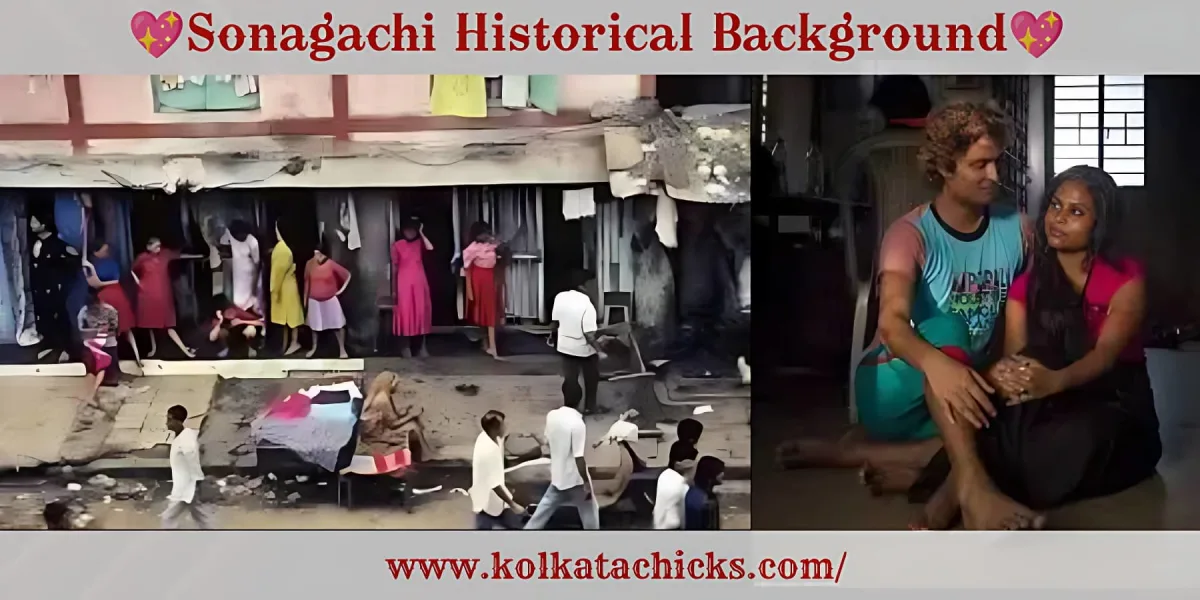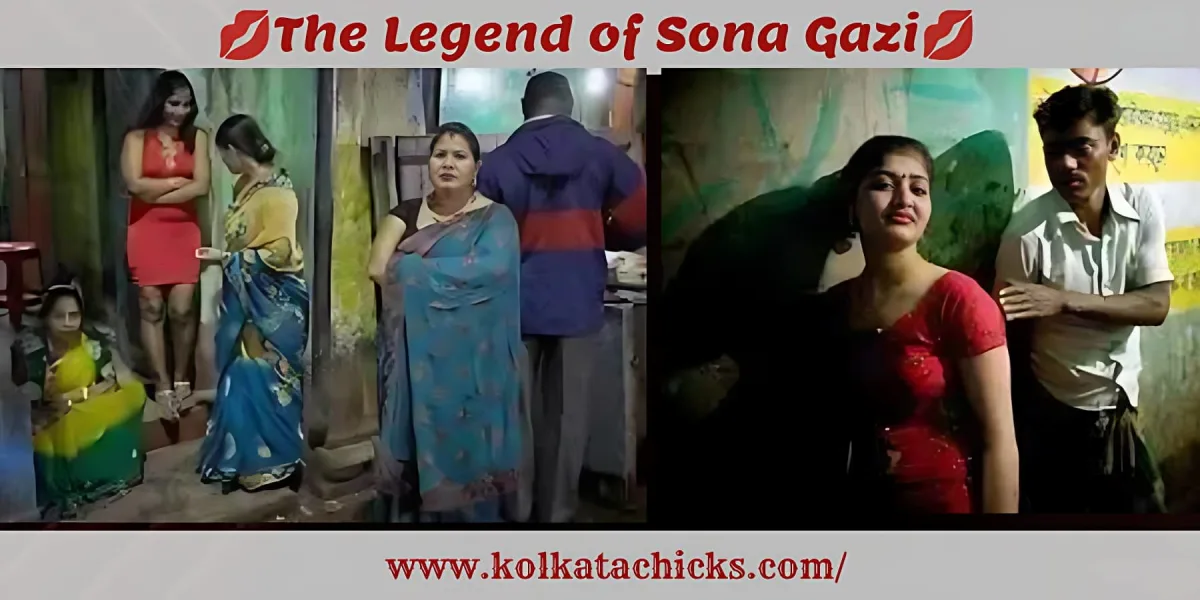Sonagachi, a well-known neighborhood in Kolkata, often referred to as the "Tree of Gold." This bustsling area has a history that goes back a long time, and it's famous for being one of the largest red-light districts in Asia. Let's explore the interesting tale behind its name and how it came to be what it is today.
In ancient times, even thousands of years ago, there were mentions of prostitution in historical records. In ancient India, there were courtesans called "Ganikas" who were part of society during a period known as the Mauryan era.
As Kolkata developed under British rule, a new class of rich people called "Babus" appeared. They had no idea that Sonagachi, once linked to a saintly figure, would become a red-light district in the future.

The story begins with a man named Sanaullah, who used to be a dacoit, a kind of outlaw. When he passed away, his mother heard what she believed was her son's voice from their small home, saying that he had become a holy warrior saint, known as a "Gazi."
People started coming in large numbers to the hut to seek blessings and cures for their troubles. In memory of her son, Sanaullah's mother built a grand mosque, which later became known as the mosque of Sona Gazi. Unfortunately, after her passing, the mosque lost its grandeur and eventually disappeared. The street where Sanaullah lived became known as Sonagachi, or the "Tree of Gold," named after the legend of Sona Gazi.
With time, Sonagachi went through changes, and sex work became prevalent in the area. Despite the challenges faced by the sex workers, Sonagachi also holds unique traditions and beliefs. For example, during the Durga Puja festival, the sacred soil collected from the brothels is considered important for making idols.
However, it's not all gloom and despair. NGOs are working hard to improve the lives of the sex workers and their children. They are providing opportunities for a better life outside the cycle of sex work.
As we continue our journey, we will learn more about Sonagachi's past, the difficulties it faces, and the positive efforts being made to bring about change. There is much to uncover about this neighborhood and the intriguing stories that lie within its boundaries.
Let's take a trip back in time to understand the historical background that shaped Sonagachi and its intriguing story.
Around 2400 BCE, historical documents mentioned the existence of prostitution, revealing that this profession has been present for thousands of years. In ancient India, during the Mauryan period, there were courtesans known as "Ganikas" who were part of the society.
As Kolkata developed during British colonial rule, a new class of wealthy people emerged, known as "Babus." They had no clue that Sonagachi, once linked to a saintly figure, would become a red-light district in the future.

With time, Sonagachi went through changes, and sex work became prevalent in the area. Despite the challenges faced by the sex workers, Sonagachi also holds unique traditions and beliefs. For example, during the Durga Puja festival, the sacred soil collected from the brothels is considered important for making idols.
However, it's not all gloom and despair. NGOs are working hard to improve the lives of the sex workers and their children. They are providing opportunities for a better life outside the cycle of sex work.
As we continue our journey, we will learn more about Sonagachi's past, the difficulties it faces, and the positive efforts being made to bring about change. There is much to uncover about this neighborhood and the intriguing stories that lie within its boundaries.
Now, let's delve deeper into the legend of Sona Gazi, the enigmatic figure who gave Sonagachi its distinctive name and historical significance.
In the early days of Kolkata, Sonagachi was the den of a notorious dacoit named Sanaullah, who lived there with his mother. When Sanaullah passed away, a remarkable event unfolded. His grieving mother claimed to have heard her son's voice from their humble hut, assuring her not to weep, for he had become a Gazi, a holy warrior saint.
Word of this miraculous transformation spread like wildfire, and people from all walks of life flocked to Sanaullah's hut. They sought blessings, remedies for their ailments, and even prayed for a better life. In honor of her saintly son, Sanaullah's mother erected a grand and beautiful mosque, which came to be known as the mosque of Sona Gazi.
However, fate took a cruel turn after Sanaullah's mother passed away. The mosque, once a symbol of devotion and piety, lost its former glory and eventually vanished from the landscape. Yet, the name "Sonagachi" endured, a testament to the legend that shaped its identity.
The term "Gazi" originates from Arabic, initially denoting a warrior. However, after the spread of Islam, it came to signify a religious warrior dedicated to advancing the cause of Islam. History reveals accounts of such warrior saints, whom poor Muslim families would appeal to for help when persecuted by local chiefs or zamindars. The Gazis would then take action, often invading the territory of the oppressor, and if victorious, they would either ensure the safety of the Muslim subjects or convert the chieftain to Islam.

The transformation of a dacoit like Sanaullah into a Gazi might seem unusual, but it isn't unprecedented. In Bengal's history, many Hindu dacoits were known to be devotees of the Goddess Kali, and some even worshipped her at temples that still exist today. These dacoits were also admired by the masses, akin to Robin Hood-like figures, who stood up for the downtrodden and fought against injustice.
As we continue our journey through Sonagachi's streets, we will unravel the complexities of its modern identity, where the tales of Kolkata call girls and Kolkata escorts intertwine with the historical legend of Sona Gazi. From its saintly origins to its current status as a red-light district, Sonagachi's narrative reflects the ever-changing tides of history and human experiences.
Sonagachi's unique history and reputation have left a lasting impact on cultural expressions and media representations. Let's explore how this neighborhood has inspired poets, filmmakers, and artists to depict its complexities and human experiences.
"Ye duniya do rangi hai" by Sahir Ludhianavi
Ye duniya do rangi hai
Ek taraf se resham ode, ek taraf se nangi hai
Ek taraf andhi daulat ki paagal aish parasti
Ek taraf jismoñ ki qeemat roti se bhi sasti
Ek taraf hai Sonaagaachi, ek taraf Chaurangi hai
Ye duniya do rangi hai
Meaning :
This world is double-faced
One side covered with silk, the other naked
On the one hand, the hedonism of blind wealth
On the other, bodies sold cheaper than bread
On the one hand lies Sonagachi, on the other Chowringhee
This world is double-faced
Sonagachi's story has also found its way onto the screen through powerful documentaries. "Born into Brothels: Calcutta's Red Light Kids" is one such remarkable documentary that won an Oscar for Best Documentary in 2005.
The film intimately portrays the lives of children born to sex workers in Sonagachi. It offers a glimpse into their daily challenges, aspirations, and the resilience that defines their existence. This documentary provides a compelling narrative of hope amidst adversity and sheds light on the complexities of growing up in such an environment.
Another noteworthy documentary, "Tales of The Night Fairies," by Prof. Shohini Ghosh and Dr. Sabeena Ghadioke, offers a more comprehensive exploration of the Sonagachi area. It received the prestigious Jeevika Award for the best documentary feature on livelihood in India. Through the lens of these filmmakers, the documentary uncovers the stories of sex workers, their struggles for rights and recognition, and their pursuit of dignity and agency.
As we peer into the heart of Sonagachi, we encounter a neighborhood teeming with contradictions, challenges, and paradoxes. While it bears the weight of being Asia's largest red-light district, Sonagachi is also steeped in unique traditions and beliefs that seem at odds with its reputation.
The very nature of Sonagachi as a red-light district brings to light the hardships faced by its sex workers. For generations, women of all ages from the same families have been involved in the sex trade, sometimes with no other viable option for survival. Trapped in a world where they are treated as commodities, these women endure immense struggles and limited opportunities. The cycle often continues as their children are denied access to education and basic amenities, leaving them vulnerable to the same fate.
The reality of Sonagachi is that some women are forced into this industry against their will. They endure physical and emotional abuse and are robbed of their agency. Escaping such circumstances can be dangerous, as those who try to run away often face even more violence and hardships.
Amidst these harsh realities, Sonagachi reveals its paradoxes. While sex workers are often looked down upon and ostracized by society, the same society seeks their blessings during religious occasions like Durga Puja. The sacred soil collected from brothels becomes a crucial element in making idols, highlighting the intertwined nature of tradition and modernity in this neighborhood.

Adding to the complexities is the presence of NGOs and organizations striving to make a positive impact on the lives of sex workers. These entities offer support, education, and opportunities for a better life outside the confines of the sex trade. Their efforts seek to break the cycle of generational bondage and provide a chance for a brighter future.
As we peel back the layers of Sonagachi's complexities, we discover the stark contrast between monetary value and human value. The red-light industry generates significant revenue directly and indirectly, yet the human cost is immeasurable. The neighborhood's struggles, hopes, and dreams intertwine, creating a tapestry that reflects the complexity of human existence.
Sonagachi may be known for its dark lanes and challenges, but within these shadows, the human spirit endures. It is a place of resilience, where women, despite facing unimaginable difficulties, continue to shine brightly like the glimmer of sarees in the evening light.
As we continue our exploration of Sonagachi, we will delve deeper into the efforts being made to bring about positive change and uplift the lives of those living within its boundaries. The journey through Sonagachi's streets is a journey of understanding, compassion, and, ultimately, hope.
As we step into the present-day Sonagachi, we encounter a neighborhood with its own unique story and challenges. Known as one of Asia's largest red-light districts, Sonagachi continues to bear witness to the complexities of human experiences.
It is challenging to provide an exact number of people living in Kolkata's red-light areas, including Sonagachi, as these communities are often transient and dynamic. However, estimates suggest that Sonagachi, being one of the largest red-light districts in Asia, is home to several thousand sex workers and their families, making it a significant population within Kolkata.
In the heart of Sonagachi's bustling lanes, sex workers face difficult circumstances. Many women and girls from the same families have been involved in the sex trade for generations, often with limited options for survival. Their lives are filled with struggles, and their children often lack access to education and basic necessities.
The reality is that some women are coerced into this line of work against their will. They endure physical and emotional abuse, making it hard to escape their difficult circumstances. Those who attempt to leave often face even more hardships and dangers.

Despite the challenges, Sonagachi also holds unique traditions and beliefs. During Durga Puja, the sacred soil collected from the brothels is considered significant for making idols. This practice reflects the blending of tradition and modernity in this neighborhood.
Amidst the difficulties, organizations and NGOs work tirelessly to improve the lives of sex workers. They provide support, education, and opportunities for a better future outside the sex trade. Their efforts aim to break the cycle of hardship and offer a chance for a brighter life.
Sonagachi's complexities reveal stark contrasts between monetary and human value. The red-light industry generates substantial revenue, yet the human cost is immeasurable. The struggles and dreams of the neighborhood intertwine, creating a tapestry of the human spirit's resilience.
Despite the challenges, Sonagachi glimmers with hope. The women here, despite facing immense hardships, continue to shine brightly like the evening light reflecting off their sarees.
As we continue our journey through Sonagachi's streets, we gain a deeper understanding of the present-day challenges and the efforts being made to bring about positive change. The story of Sonagachi is one of resilience, compassion, and hope, reminding us of the power of the human spirit to endure and strive for a better tomorrow.
As we glimpse into the future of Sonagachi, we see a neighborhood seeking change and progress. While it continues to face challenges, there is hope for a brighter tomorrow.
Organizations and NGOs are working tirelessly to uplift the lives of sex workers and their families. They offer support, education, and opportunities for a better future beyond the confines of the sex trade. These efforts aim to break the cycle of hardship and provide a chance for a new beginning.
The women of Sonagachi, despite their struggles, continue to shine brightly with resilience. Their dreams and aspirations flicker like the evening light reflecting off their sarees.
The community's unique traditions and beliefs add depth to its identity. During Durga Puja, the sacred soil from the brothels is considered significant for making idols, showcasing the blending of tradition and modernity.
While Sonagachi faces challenges, its story is one of hope. It is a reminder of the human spirit's strength to endure and seek a better future.
As we conclude our exploration of Sonagachi, we carry with us a deeper understanding of its complexities, struggles, and aspirations. The journey through this neighborhood reveals the power of compassion and hope, pointing towards a future where positive change is possible. Sonagachi's story continues to unfold, reflecting the ever-changing tides of history and the human spirit's resilience in the face of adversity.